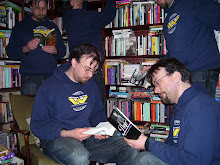
CAUSTIC COVER CRITIC: What's your background in design? How did you get into books specifically?
TONY PALMER: My whole career has been in book design, except for a minor divergence into advertising in the late 1980s. I kind of blundered into books, mostly because I had no idea what I was doing and because I knew nothing about design. But the book publishing industry seemed to welcome my disorientation and lack of talent with an openness that seems hard to believe nowadays. That was in 1986. Today jobs in publishing are sought after with a passion and cunning that would have left me for dead back then. Actually, today I’m no smarter than what I was than when I was fifteen, God knows how I’ve survived. I think I stayed with books and with book design because early in my career I met a great designer at Macmillan, Michael Wood. He got me to see typography and layout in a way that changed my life.


CCC: How big is the team you head at Penguin Australia? How many covers would you tackle in a year?
TONY PALMER: Well, I’m not really in charge at Penguin. Like all the other designers I answer to our Art Director, Deborah Brash. There’s about a dozen of us in Melbourne and four or five in the Sydney studio. She has a really tough job. She must oversee hundreds of designs in a year and is responsible for them all. It’s always hard to quantify the number of titles any of us work on in a year – if a designer is working on our cooking and lifestyle list they might only work on three or four books, but if a designer is focussed on our fiction list they might design as many as fifteen or twenty books.
 [CCC: An aside--Sonya Hartnett's Of a Boy had a similarly shattering effect on me to that of Coetzee's Disgrace. An excellent book, but incredibly sad. And that's aside from the fact that it draws on a famous unsolved missing children case from my home city.]
[CCC: An aside--Sonya Hartnett's Of a Boy had a similarly shattering effect on me to that of Coetzee's Disgrace. An excellent book, but incredibly sad. And that's aside from the fact that it draws on a famous unsolved missing children case from my home city.]CCC: What are some recent covers of which you're most proud? What about older work?
TONY PALMER: It’s hard to pick them. I remember some titles where I never want to even utter their name again. Usually this is because of the traumatic design journey they have been put through. In one way it’s a kind of the nice thing about my job, but it’s also the horrible chewing-on-gravel kind of thing too – the people I work with love books. They love them so much. Maybe it’s a weird pathological state. And it can be great. But it can also drive you nuts.



Sometimes you hear the bigger book publishers described as being like factories - where the work is churned out in a mechanical and unthinking way. It’s never been like that for me at Penguin. The editors, production staff and designers all love their work. But love can be wild and unpredictable. So I’ve dreamt of being a plumber. I like the way water moves on surfaces. I like the fact that there are only four different ways to plumb a house. But book design? Gawd, maybe there’s about 120 right ways to do a good book cover, and there are probably millions of ways to make a bad one.
I was once in love with my cover of Surrender, by Sonya Hartnett. It did what Cartier-Bresson demanded of his photographs – ‘You don’t want your audience to read the photograph, you want them to feel it.’ I still have a fondness for that cover. Sometimes I bring it out and have a whisky or two. But a designer can’t live in the past, there’s a whole wide world of new prose being keyed, right now.

CCC: You've seen the change from paper and paste-up to digital design: is there anything you miss from the pre-Adobe age? Are there any old techniques that can't be replicated satisfactorily?
TONY PALMER: Yes. Everything. OK, I’m going to sound really old and really lame now. I can see my teenage daughters cringing as I key this. But working digital? Meh. You are only a dog on a chain. Every year the software companies flow out the new stuff. It’s great. Yes. I use it all the time. But in the end it’s only adding more links in the chain. My internal dialogue with design is ‘get off the computer, bring the design to the technology, don’t let the technology direct the path’. And I’m trying to be good, and make a point of drawing out my roughs.

Prior to the mid 1980s all book designers worked and thought this way and they did good work. Today the design concepts are often finished before they are started. Hell will be a place where I am forced to review my own designs where I was lazy and didn’t do the work before I opened Photoshop.
CCC: What's your feeling on the whole book importation debate currently happening here in Australia? I can't imagine it would do local book designers much good.
TONY PALMER: It’s a complex debate. But I think I can see where this might end if the import regulations are changed. Publishing houses are businesses. They will just shift their list towards product that can’t be emulated overseas. There will be less risk taking, less inclination to nurture new and local writers. It will not be good. I suppose we can say that our governments should have no place in protecting the creativity of its culture, but to me this is folly. Healthy cultures, cultures that look after their sick and disadvantaged, cultures that are strong and wise and prosperous have always walked hand in hand with the health of their arts.

CCC: Are you surprised at the number of book cover design sites which have popped up on the net?
TONY PALMER: No, not really. I’m convinced that the digital revolution has in an unintended way elevated the status of print work. Books are artifacts. Things you can hold and feel and smell – real objects that contain every conceivable expression of what it means to be human. My daughters are gagging at me now. Better shut up. But I hate mobile phones. Whoops. In fact the whole digital age is crap. OK, shutting up now. Quiet. Yes.


CCC: If you could design, inside and out, without budget limitations, any book from the history of literature, what would it be?
TONY PALMER: Wow. Didn’t expect a question like that. And it’s funny, I can’t pick one. I really do have a lot of favourite books, As I Lay Dying, Gilead, Love in the Time of Cholera . . . but this is the thing. I’m not a fine artist. I work for someone else in a commercial world. Jobs come to me and the first thing I ask is ‘who is this for?’ rather than, ‘what should this look like?’ I work within the confines of my employer’s and the author’s creative vision. I suppose this makes the work I do more of a craft than an art form. But I like that. To be good at making something that other people value is immensely satisfying. Craft skills can never be taken away from you even if the craft itself becomes redundant.
I also think there is a lot to be said about design being unconscious of itself as design. Book covers are cultural snapshots of a time and a place. And it is this quality that makes even the bad ones interesting. Actually sometimes the bad ones are really good. If I set out to redesign something for my own aesthetic satisfaction, well it would probably be a failure. I don’t think I could do it.
But, alright. I choose The Master and Margarita, because I would like just once in my career to commission an illustration of a human-sized cat.
CCC: Is there any neglected book you'd like to force people to read?
TONY PALMER: The Personal Memoirs of U S Grant. Yes, it’s military history. Yes, its over 800 pages long. But I don’t think there is a better example in the English language of a writer who uses verbs. I love verbs.

CCC: Thank you, Mr Palmer!





2 comments:
GREAT interview! How do you get to meet all these fantastic people. Your life must be like a really fun carnival, except without the burden of toothless carnies.
The cover of Landcape with Animals is really, really great. I don't even know what it's about and the cover really makes me want to read it.
It's so desperate and feverish—like you want to hyperventilate at it.
Thanks, Christy! I should put that possibly erroneous description of my life on my resume. And the 'Landscape...' cover really is nice, too. When you look at it closely it has this lovely texture to it.
Post a Comment